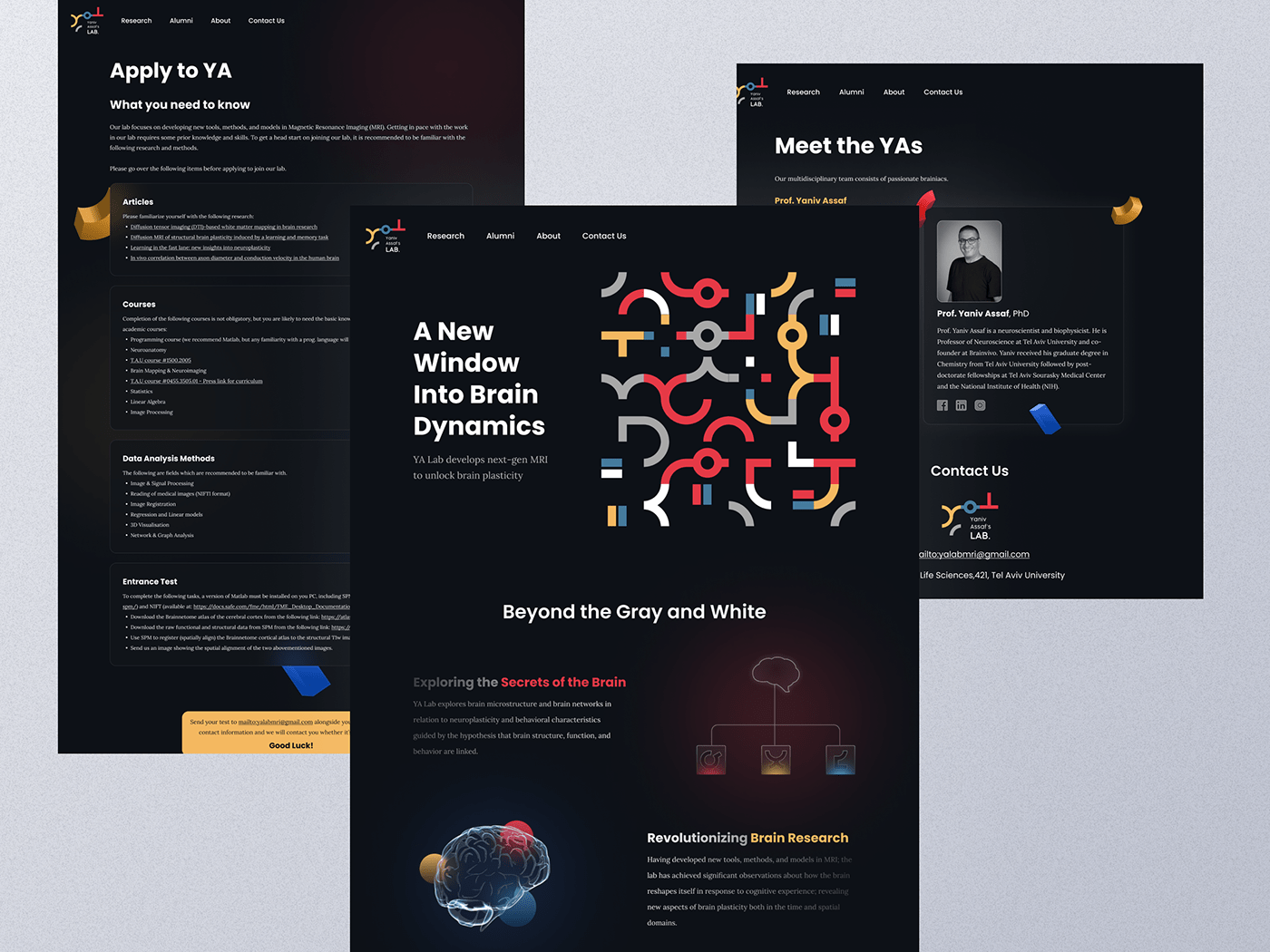

Case Study: Yaniv Assaf's Lab Website - Embracing Mystery and Advancement in Brain Research
Introduction:
This case study highlights the successful design and development of a website for Yaniv Assaf's Lab, a prestigious brain research laboratory at Tel Aviv University. The objective was to create a captivating website that effectively communicates the lab's mission, showcases the expertise of Prof. Yaniv Assaf, attracts potential interns, and impresses potential donors and benefactors. The website features a dark and enigmatic aesthetic, complemented by 3D brain-related graphics, movement, and glassmorphism, creating an immersive experience.
Design Concept and Approach:
Dark Aesthetic: To evoke a sense of vastness, mystery, and the exploration of the unknown, a dark color scheme was employed. The website's dark background creates a captivating ambiance, reminiscent of the secrets and complexities of the brain. The dark aesthetic establishes a unique visual identity for the lab and sets it apart from conventional research websites.
3D Brain-Related Graphics: Incorporating 3D graphics related to the brain enhances the visual appeal of the website and reinforces its focus on brain research. These graphics provide a visually stimulating and engaging experience for visitors, fostering a sense of curiosity and interest in the lab's work. The use of 3D elements adds depth and realism to the website, capturing the intricacies of the brain.
Movement and Glassmorphism: To further enhance the user experience, subtle movements and animations were incorporated throughout the website. These animations create an interactive and dynamic feel, keeping visitors engaged and adding an element of intrigue. Glassmorphism, a design trend that combines transparency and blurring effects, was employed to create a modern and futuristic look, aligning with the lab's cutting-edge research.
Website Structure and Pages:
Home Page: The home page serves as the primary entry point, introducing visitors to the lab's research focus and highlighting the expertise of Prof. Yaniv Assaf. It features concise yet compelling information about the lab's mission, its contributions to brain research, and the notable achievements of Prof. Assaf. The carousel with blog posts leading to published articles showcases the lab's thought leadership and establishes credibility.
Lab Members and Alumni: This page provides visitors with an overview of the lab's team, including both current members and distinguished alumni. Brief profiles of lab members highlight their expertise and accomplishments, further establishing the lab's credibility and expertise in the field.
Internship Page: The internship page targets students interested in joining the lab for internships. It outlines the requirements and tests that applicants need to pass, providing clear guidelines for interested individuals. This page serves as a call to action, inspiring students to apply and contribute to groundbreaking brain research.
Results and Impact:
Engaging Visual Experience: The dark aesthetic, 3D graphics, movement, and glassmorphism collectively create an immersive and visually captivating experience for website visitors. This unique visual identity fosters a memorable impression of the lab and its research, leaving a lasting impact on potential interns, donors, and benefactors.
Increased Interest and Engagement: The website effectively communicates the lab's research focus, the expertise of Prof. Yaniv Assaf, and the accomplishments of the lab members. It piques the interest of potential interns, inspiring them to join the lab for valuable learning experiences. Additionally, the captivating design and informative content engage potential donors and benefactors, encouraging them to support the lab's important work.
Enhanced Credibility and Perception: The carefully designed website enhances the lab's credibility by showcasing its research focus, the expertise of the lab members, and the achievements of Prof. Yaniv Assaf. The visually appealing and immersive experience leaves a positive impression, reinforcing the lab's reputation as a leading research institution in the field of brain research. The professional and visually impressive presentation of the lab's work instills confidence in potential donors and benefactors, making them more likely to support the lab financially.
Increased Internship Applications: The dedicated internship page provides clear information and requirements for students interested in joining the lab for internships. The captivating design and comprehensive details attract a higher number of qualified applicants, ensuring a competitive pool of talent for the lab to choose from. This strengthens the lab's research capabilities and fosters the development of future brain researchers.
Positive User Experience: The website's intuitive navigation and engaging design elements contribute to a positive user experience. Visitors can easily explore the lab's research focus, learn about Prof. Yaniv Assaf's expertise, and access relevant information. The seamless user experience enhances engagement and encourages visitors to spend more time on the website, increasing the likelihood of conversion and further interaction with the lab.
Conclusion:
Through the strategic use of a dark aesthetic, 3D brain-related graphics, movement, and glassmorphism, Uxplained successfully designed a captivating website for Yaniv Assaf's Lab. The visually immersive experience, coupled with informative content, effectively communicates the lab's research focus, attracts potential interns, and impresses donors and benefactors. The website's impact is evident in increased engagement, internship applications, and enhanced credibility within the field of brain research. The collaboration between Yaniv Assaf's Lab and Uxplained has resulted in a website that embodies the lab's mission and advances its position as a prominent research institution in brain studies.


